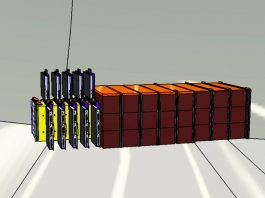The Experimental Particle Physics group at the University of Bergen’s Department of Physics and Technology has joined forces with Institute of Theoretical Physics at the University of Warsaw to decipher possible signals from the early Universe in particle collisions at the LHC.
One of the most exciting areas of research in physics has been the interdisciplinary field of cosmology and particle physics. The Experimental Particle Physics group at the University of Bergen’s Department of Physics and Technology has joined forces with Institute of Theoretical Physics at the University of Warsaw to decipher possible signals from the early Universe in the particles collisions at the Large Hadron Collider (LHC). The project is supported by the Norwegian Financial Mechanism 2014-2021. It is devoted to fundamental research contributing to the construction of a deeper than the Standard Model (SM) theory of elementary interactions that would help to understand the history of the early Universe.
The project is focused on the full exploration of the opportunities that will be provided by the collider experiments in the foreseeable future in terms of the upgrades to the LHC. It will result in improved methods of the data analysis and of their presentation, based on the guidance of a broad spectrum of new and existing theoretical models, analysed from a new angle with regards to documenting the similarities and differences in their experimental signatures. In several instances, new data analysis techniques and new theoretical constructions will be investigated.
Why should we care about what happened in the early Universe?
The Standard Model of particle physics has, so far, survived scrutiny via a long series of experiments. The hunt for the last missing piece of the model, the Higgs boson, motivated the construction of the LHC at the European Laboratory for Particle Physics (CERN). However, finding the Higgs boson created more puzzles than it solved.
The present ‘look’ of the Universe could be determined by so-called ‘phase transitions’ – spectacular phenomena known in everyday life – turning boiling water into a vapour, or condensing vapour back to liquid water is perhaps the most often-observed first-order phase transition.
The SM describes the history of the Universe as starting about a millionth of a second after the Big Bang, when the so-called phase transition in strong interactions happened, something that has been confirmed by numerous astrophysical observations. This is when the ‘liquid drops’ containing the presently-known nuclear particles first formed in the gas of quarks and gluons – the quark-gluon plasma. But before that, the mysterious ‘electroweak phase transition’ occurred, leaving behind the matter that makes all the visible objects in the Universe. This matter, which is precisely described by the Standard Model, however, constitutes only about 5% of the matter-energy budget of the Universe. The SM is unable to explain why even this 5% exists, and has not annihilated with antimatter.
CP symmetry
The charge-parity (CP) symmetry needs to be violated more strongly than the SM accounts for in order to explain this excess of matter over antimatter. An interesting option is that baryonic (‘normal’) matter arose during the Electroweak Phase Transition (EWPT), which would need to be a first-order type of transition. However, the SM, as it is presently known, requires a second-order EWPT.
The fact that the Higgs boson decays into tau leptons offers an opportunity to detect a possible violation of charge-parity symmetry not accounted for, so far, by the SM. Another opportunity is presented by the characteristics of the associated production of the Higgs boson and the heaviest quark – the top quark – at the LHC. These are the example signatures that we will continue to pursue at the soon-to-come Run Three, as well as at the High Luminosity LHC runs beyond that.
Beyond Standard Model processes that can induce first-order EWPT often also modify the subtle interactions that the Higgs boson has with itself. Pin-pointing Higgs boson self-interactions is one of the flagship measurements for High Luminosity LHC. The link between these interactions and the type of EWPT is far from being straightforward and depends on what kind of new particles or interactions exist beyond the SM realm. We will pursue this subject from both the theoretical and experimental sides, proposing new types of measurements and theoretical links.
Dark matter and dark energy
Astrophysical and cosmological observations demonstrate that 75% of the Universe is made of dark energy, the nature of which remains unknown. Out of the remaining matter, 80% is in the form of dark matter (DM) particles, whose properties differ from all particles contained in the SM. DM plays a crucial role in the evolution of the Universe and thus of life itself, and yet we know little about it, except for its gravitational interactions. There could even be a variety of different DM-made structures around us that we perceive only via gravity. Since DM was apparently produced in the Big Bang, there is also the possibility that it is also produced in the ‘micro–Big Bangs’ of the LHC collisions. We are therefore endeavoring to spot it in the ATLAS Detector by testing new theoretical avenues relating to where the DM might be hiding.
Data analysis at the LHC
The scale of the LHC’s experimental programme demands that we do our utmost to extract relevant information from the collected data. The tremendous development in Machine Learning (ML) and a set of deep learning techniques allows us to develop pioneering analysis techniques to distinguish between similar signatures arising from very different theoretical scenarios.
Artificial intelligence and ML play an important role in our society and already have a major impact on our lives. Numerous cases of where ML algorithms have produced decisions leading to unacceptable biases related to, for instance, race or gender, have also come to the public’s attention.
Our group, along with particle physics community generally, is trained to critically analyse large and complex data sets. We are trained to identify and avoid biases, have a strong focus on accounting for systematic uncertainties, and on scrutinising that the training set represents the data in all aspects. All these features are of paramount importance when applying and developing powerful AI and ML algorithms. Decisions made by ML algorithms are, by their nature, opaque; it is hard to understand why a certain decision is made. We focus on understanding the decisions made by the ‘black box’ algorithms, and develop new tools to achieve this. There is also a potential important societal impact to be made from the development of ML methods in particle physics, and in our project in particular.
Further information
This article is supported by L Melzers Hoyskolefond and the Norwegian Financial Mechanism for 2014-2021.
Please note, this article will also appear in the sixth edition of our quarterly publication.









